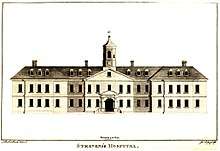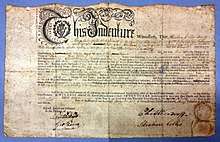Philip Woodroffe
Philip Woodroffe (died 4 June 1799) was the resident surgeon at Dr Steevens' Hospital in Dublin for over 30 years. Several eminent surgeons were apprenticed to him. He was the president of the Royal College of Surgeons in Ireland (RCSI) in 1788.


_p049_THE_COLLEGE_OF_SURGEONS.jpg)
Early life
In his history of the RCSI, Charles Cameron wrote that he had been unable to learn anything about Woodroffe's parents or early life.[4]
Career
Woodroffe was appointed assistant-surgeon to Dr Steevens' Hospital in 1763, and resident surgeon from 1765, an office which he held until his death.[4] In 1780 he became surgeon to the House of Industry Hospitals and remained so for the rest of his life.[5] In 1769 he was living in Crow Street; he moved to Fownes Street in 1774, and in 1784 he was living in St Andrew's Street.[4]
He was one of the founding members of the Dublin Society of Surgeons that later became the Royal College of Surgeons in Ireland, and was one of those to whom the first charter was granted in 1784. In 1786 he followed William Dease as treasurer to the college, and held the office for eight years.[4] He was president of the college in 1788.[6] Woodroffe's appointments also included surgeon to the Blue Coat School, the Foundling Hospital, and the Hospital for Incurables, Lazar's Hill (now Townsend Street). Several notable surgeons such as Abraham Colles were apprenticed to him.[4] Colles took over as resident surgeon at Steevens' Hospital after Woodroffe's death in 1799.[7]
Death
Woodroffe died on 4 June 1799, in St Andrew's Street, and was interred in St. Andrew's churchyard.[4]
John Gilborne wrote the following verse about Woodroffe:
- "Woodroffe redresses all chirurgic Woes,
- Amputated stumps he covers with Lambeaux,[lower-alpha 1]
- To make the maim'd live out their Time with ease:
- A Practice quite unknown in ancient days."[4]
Notes
- French: "Lambeaux means flaps of skin".
References
- DG18 Dr Steevens' Hospital. Dublin City Council. Retrieved 4 May 2018.
- Heritage Week at RCSI. Heritage Collections of the Royal College of Surgeons in Ireland, 23 August 2013. Retrieved 7 May 2018.
- Dublin delineated in twenty-six views, etc. Dublin: G. Tyrrell, 1837. p. 49.
- Cameron, Sir Charles A. (1886) History of the Royal College of Surgeons in Ireland, and of the Irish Schools of Medicine &c Dublin: Fannin & Co. p. 312.

- O'Brien, Eion, Lorna Browne, Kevin O'Malley. (Eds.) (1988) The House of Industry Hospitals 1772–1987. The Richmond, Whitworth and Hardwicke (St Laurence's Hospital): A Closing Memoir. Monkstown: Anniversary Press. p. 296. ISBN 1870940024
- RCSI Presidents since its foundation in 1784. Royal College of Surgeons in Ireland, 2015. Retrieved 2 May 2018.
- Mostofi, Seyed Behrooz (Ed.) (2005). Who's Who in Orthopedics. London: Springer-Verlag. p. 74. ISBN 1-85233-786-9.CS1 maint: extra text: authors list (link)
External links
![]()